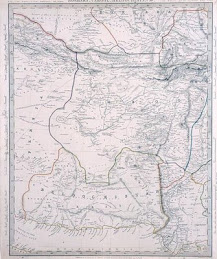|
February 1, 2011
 As the Islamist nightmare envelops Pakistan, the Obama administration ponders what the United States should do. But the bitter reality is that the United States is already doing too much in Pakistan. It is the American shadow everywhere, the Pakistani feeling of being smothered by the U.S. embrace, that gives the Islamists their principal rallying cry.
As the Islamist nightmare envelops Pakistan, the Obama administration ponders what the United States should do. But the bitter reality is that the United States is already doing too much in Pakistan. It is the American shadow everywhere, the Pakistani feeling of being smothered by the U.S. embrace, that gives the Islamists their principal rallying cry.Evidence is everywhere of what the Economist calls “a rising tide of anti-American passion.” The leading spokesman of traditional Muslim theology, the Jamiat Ulema-e-Islam (JUI), opposes the “war on terror” because “it is an American war” and blames a U.S. plot for the recent assassination of the moderate Punjab governor, Salman Taseer.
The endless procession of U.S. leaders paying goodwill visits to Islamabad, most recently Vice President Joe Biden, evokes sneers and ridicule in the Urdu-language press, accompanied by cartoons showing Pakistanis scratching fleas crawling over their bodies. The late special envoy to Pakistan and Afghanistan, Richard Holbrooke, liked free-swinging encounters with Pakistani journalists that left a trail of bitterness expressed in the Urdu media, but this did not deter Holbrooke and Secretary of State Hillary Clinton from return visits.
To calm the situation down, the United States should start by phasing out drone attacks in the Pashtun border areas with their massive civilian casualties and should end the $1 billion plus in annual subsidies to the armed forces that make them look like American puppets. At the same time, less visible education and development aid provided by the Kerry-Lugar bill should be continued, together with the International Monetary Fund credits that keep the Pakistani state afloat, and access to U.S. markets for Pakistani textile exports should be increased.
Instead of publicly prodding the Punjabi-dominated armed forces to step up their offensive against Pashtun tribal militants in the Afghan border areas, the United States should recognize that Islamabad is afraid of stirring up Pashtun ethnic sentiment there that could break up the fragile multiethnic Pakistani federation.
The Pashtuns of the former–Northwest Frontier Province (now called Kyber Pakhtunkhwa) and the Federally Administered Tribal Areas (FATA) have an ancient history of resisting Punjabi incursions, but the Army did not come into direct conflict with the Pashtuns following the creation of Pakistan until July 2002, when, at the behest of the United States, it sent a division into FATA to attack al-Qaeda and Taliban forces at key transit points on the Afghan border. Heavy casualties resulted, displacing some fifty thousand people. This was a historic break with the autonomy agreements negotiated by the British with FATA tribes and honored until then by Pakistan. As the “war on terror” has proceeded, the FATA Pashtuns have been politicized and radicalized as never before.
The underlying reason that Pakistan’s U.S. links are so unpopular and make such a tempting target for the Islamists is that America is perceived as anti-Muslim.
The Islamists focus not only on Muslim casualties in next door Afghanistan, but above all on U.S. support for Israel and on the American military presence throughout the Arabian Sea , the Indian Ocean and the Persian Gulf in areas near Pakistan.
Why does the United States keep pouring aid into Pakistan despite its active support for the Taliban in Afghanistan at the expense of U.S.-NATO forces and its inability or unwillingness to help the United States root out al-Qaeda from its mountain sanctuaries?
American officials point to its arsenal of seventy to ninety nuclear weapons, arguing that a tight U.S. embrace of the Pakistani military and intelligence elite is necessary to make sure that another nuclear-proliferation racket does not emerge like the one organized by nuclear czar A. Q. Khan.
This is an understandable concern because many of the same generals who colluded with Khan are still in high places. But the larger danger to the United States is that the nuclear arsenal will fall into the hands of the Islamist sympathizers inside the nuclear establishment, or that the Islamists will completely take over the armed forces, branding current military leaders as U.S. stooges.
While doing less elsewhere in Pakistan, the United States should do more to support anti-Islamist forces along the southern Arabian Sea coast. First, it should support anti-Islamist Sindhi leaders of the Sufi variant of Islam with their network of 124,000 shrines. Most important, it should aid the 6 million Baluch insurgents fighting for independence from Pakistan in the face of growing ISI repression. Pakistan has given China a base at Gwadar in the heart of Baluch territory. So an independent Baluchistan would serve U.S. strategic interests in addition to the immediate goal of countering Islamist forces.










































No comments:
Post a Comment